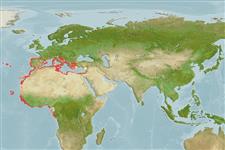Common names from other countries
>
Kurtiformes (Nurseryfishes, cardinalfishes.) >
Apogonidae (Cardinalfishes) > Apogoninae
Etymology: Apogon: Greek, a = without + Greek pogon = chin, beard (Ref. 45335).
More on author: Linnaeus.
Environment: milieu / climate zone / depth range / distribution range
Ecologia
marinhas associadas(os) a recifes; não migratória; intervalo de profundidade 10 - 200 m (Ref. 4738). Subtropical; 45°N - 5°S, 32°W - 36°E
Eastern Atlantic and Mediterranean Sea: Portugal to Morocco and the Azores. Elsewhere, southward to Gulf of Guinea.
Tamanho / Peso / Idade
Maturity: Lm ? range ? - 5.5 cm
Max length : 15.0 cm SL macho/indeterminado; (Ref. 4738); Idade máx. registada: 5 anos (Ref. 93355)
Descrição breve
Chaves de identificação | Morfologia | Morfometria
Espinhos dorsais (total) : 7; Raios dorsais moles (total) : 9 - 10; Espinhos anais: 2; Raios anais moles: 8 - 9. Eye very large, much greater than snout. Pectoral fin long, reaching at least origin of anal fin. Preopercular edge only slightly serrated, preopercular ridge smooth. Body and fins red or pink, back and upper surface of head dusky. Two or three dark spots, sometimes joined, along base of caudal fin.
Occasionally forms schools; sometimes solitary. Inhabits muddy or rocky bottoms and caves (Ref. 4738). A sciaphilous species thriving in a number of shady/dark habitats and frequents marine caves, where it forms large schools (Ref. 118281). Feeds on small invertebrates and fishes (Ref. 4738). Observed to feed in the water column and just over the bottom, always at night; 93.4% of observed events occurring outside the caves, usually on rocky bottoms and Posidonia oceanica meadows, and to a lesser extent on pebbles (Ref. 118281). Oral brooding by males (Ref. 4738).
Males incubate eggs in buccal cavity (Ref. 205, 4738, 74407). Embryos do not feed externally in the buccal cavity. Distinct pairing during courtship and spawning (Ref. 205). Internal fertilization and paternal care by mouthbrooding is found to be a rare combination of reproductive strategy (Ref. 74407). Also Ref. 240.
Tortonese, E., 1986. Apogonidae. p. 803-809. In P.J.P. Whitehead, M.-L. Bauchot, J.-C. Hureau, J. Nielsen and E. Tortonese (eds.) Fishes of the north-eastern Atlantic and the Mediterranean. UNESCO, Paris. vol. 2. (Ref. 4738)
Categoria na Lista Vermelha da IUCN (Ref. 130435)
CITES (Ref. 128078)
Not Evaluated
Ameaça para o homem
Harmless
Utilização humana
Pescarias: espécies comerciais; isco:
Ferramentas
Relatórios especiais
Descarregue XML
Fontes da internet
Estimates based on models
Preferred temperature (Ref.
115969): 13.3 - 20.9, mean 16.3 (based on 216 cells).
Phylogenetic diversity index (Ref.
82804): PD
50 = 0.5000 [Uniqueness, from 0.5 = low to 2.0 = high].
Bayesian length-weight: a=0.01096 (0.00658 - 0.01826), b=3.11 (2.97 - 3.25), in cm Total Length, based on LWR estimates for this species & Genus-body shape (Ref.
93245).
Nível Trófico (Ref.
69278): 3.4 ±0.61 se; based on food items.
Resiliência (Ref.
120179): Médio, tempo mínimo de duplicação da população 1,4 - 4,4 anos (K=0.90; tmax=5).
Fishing Vulnerability (Ref.
59153): Low vulnerability (15 of 100).
